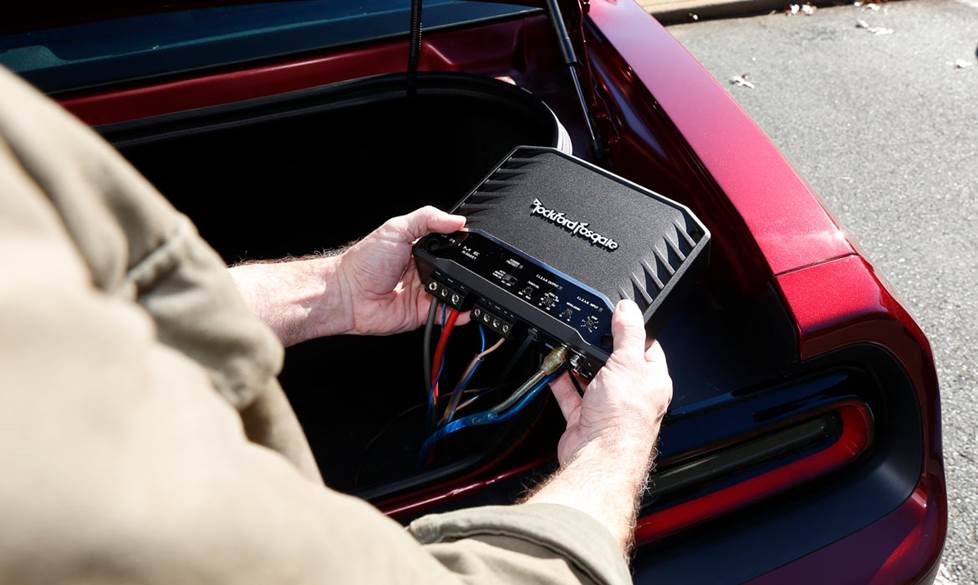Understanding the amplifiers and their settings is crucial in audio systems to achieve optimal sound quality. The low-pass filter (LPF) is designed to fine-tune the audio and get the best performance from your subwoofers by setting LPF on amplifiers. These low-pass filters, which might be passive or active depending on their power source, are essential for eliminating distortions.
Understanding how to use low-pass frequency to protect your speakers or improve bass performance is critical. Consequently, this article will explain in detail “what the low-pass frequency on AMP is” and how to set it correctly and without problems.
What is the Low Pass Frequency?
An amplifier’s low pass frequency, often a low-pass filter, is a crossover filter network. It efficiently reduces high-frequency signals and allows signals below the set point to pass through. Therefore, it removes higher frequencies or distorted and hissing noises that may have occurred during the recording.
For instance, adjusting the low-pass filter on a car audio system to 80Hz can allow lower-frequency signals to get through while obstructing higher-frequency sounds. Furthermore, an LPFs effectiveness depends upon several factors, such as its design, the type of filter selected, and the selected cutoff frequency.
LPF attenuates signals higher than the cutoff frequency, which can be described as the signal falling to half of its power -3dB. These filters can be passive or active depending on their power intake. Furthermore, you can adjust the filters to different cutoff frequencies for a customized experience. By fine-tuning LPF to other audio systems, you can ensure that only the desired signal frequency gets through.
Understanding the Technical Aspects of Low Pass Filter
Types of LPF
Low pass filters are required to attenuate high-pitched frequencies and adjust the audio precisely. Therefore, there are two primary LPF filters, and you must choose the one that best suits your needs.
- Passive LPF

Generally, these filters use a combination of resistors and capacitors to control the frequencies and cannot provide amplification. Therefore, they can only maintain or reduce the amplitude of the input signal. The filters require no external power source and are simple to design and implement.
Also, the value of capacitors and resistors determines the cutoff frequency in passive RC filters. As a result, they are perfect for basic applications but cannot provide sufficient gain for more complex tasks.
- Active Filters

Like operational amplifiers with capacitors and resistors, active filters also need an external power supply. As a result, they provide more flexibility in signal processing, allowing for precise gain and frequency response adjustments. Active filters are employed for various features, such as a steeper roll-off (Chebyshev filter), flat passband (Butterworth filter), and linear phase response (Bassel filter).
Cutoff Frequency

It’s the frequency at which the filter starts to attenuate the signals. It should be lower than the highest signal frequency but higher than the lowest frequency. The -3db is the standard reference point at which the output signal’s power drops to half its maximum value point.
This point is critical because it marks the boundary between the passband (signals to pass through) and the stopband (attenuated signals).
Slope or Resonance

The slope or resonance of the filter defines how sharply it responds and blocks out high-pitched sounds. The steeper the audio slope, the more the high-frequency signal filter attenuates. Some low-pass filters have a resonance button to enhance or fine-tune the sound at the cutoff point where the filter starts blocking high-pitched sounds.
How to set up a Low Pass Filter on an Amp?
It is essential to determine the type of amplifier you are working with to set up a low pass frequency on an amplifier. However, hereunder is a general process applicable to most of the amps.
Step 1- Adjust the Cutoff Frequency

The cutoff frequency is set depending on the type of audio system and your speaker and subwoofers.
- With the amp gain set low, play some music while gradually increasing the volume until it starts distorting. Then, lower the volume and mark the point where sound becomes apparent.
- Next, turn up the amp gain until you hear distortion.
· Once there is no more distortion, reduce the gain and adjust your amplifier accordingly.
Step 2- Adjust the LPF settings

- Rotate the knob in a clockwise direction to reduce the sub-amplifier gain to its minimum.
- Most amplifiers have an LPF dial or knob with a 40–250 Hz range. Turn on the low-pass frequency and start at a higher frequency.
- Then, gradually lower it until you hear clear and distortion-free bass sounds.
Note: It’s necessary to avoid using low-pass filters, bass boosts, and crossovers on the amplifiers and receiver to prevent distortion.
Step 3- Subwoofer gain

- Turn up the volume of the receiver while playing the music
- Then, slowly turn up the amplifier gain until the subwoofer sound overpowers the speakers without distortion
- After that, slowly adjust the low-pass filter downward till midrange and high-frequency notes disappear
Step 4- Subsonic Filter and Bass Boost

- If your amplifier has a bass boost, turn it up slowly and analyze its impact on the sound
- However, if there’s distortion after turning the bass boost, then switch off the amp gain
- Also, for ported subwoofers, use a subsonic filter to bring down loud, low-noise notes and fine-tune the audio.
Step 5- Match Subwoofer level with receiver volume
- Turn up the volume until the sound starts distorting.
- Then, turn up the subwoofer volume till you balance the bass sounds with the rest of the track.
Troubleshooting LPF Issues
While setting up low-pass frequency on an amplifier is easy, you may encounter several issues affecting the overall system performance. Therefore, understanding these problems and how to solve them is essential for optimal sound quality. The most frequent issues that can arise are described below.
Incorrect LPF or Cutoff frequency Settings
If an LPF is not designed correctly or its cutoff frequency is too high or too low, it may disturb the smooth functioning. As a result, if it’s set too high, it may play higher-pitched sounds that it cannot handle, resulting in distortions. Also, if the cutoff frequency is too low, it may block the desired signals, resulting in distortions or noticeable gaps.
Solution: You need to adjust the low-pass filter parameters to fit your needs and set up the audio to remove the issue. You can also fine-tune the audio by increasing or decreasing the LPF by listening to music.
Nonlinear Distortions
Nonlinear distortions can occasionally occur when the filtered signal is too large, and the filter becomes saturated. As a result, it can introduce different unwanted frequencies, resulting in distortions or unpleasant audio effects.
Solution: This problem can be resolved by reducing the signal strength or incorporating a high-power capacity filter. However, if a flawed circuit design is the cause of the issue, it must be redesigned and removed.
Electrical Interface and Noise
Noise in the audio system is caused by poor design or component quality and electrical interface from adjacent electrical equipment. Furthermore, high-frequency signals may introduce noise in the form of static or humming sounds.
Solution: Use high-quality electrical components or filters with a higher blocking rate to minimize the interference. Also, ensure the LPF is appropriately designed and move the amplifier away from potential sources of electromagnetic interference.
Phase Shift
Phase shift happens when an incorrect filter is selected, and higher-order filters are responsible for the phase shifts. Moreover, if there is a misalignment between the subwoofer phase and the main speakers, the sound waves from different speakers cancel out each other. It shows inconsistent or weak bass despite having correct LPF settings.
Solution: Lower-ordered filters are used to remove the phase shift issues. Furthermore, the subwoofer or amplifier’s phase control can produce a uniform bass response. The correct phase setting will vary depending on the subwoofer positioning relative to the speakers.
Thus, the phase must be adjusted to 0°, then gradually moved to 180° while listening to the music and pausing when the bass reaches its maximum level.
Importance of Proper Low Pass Frequency Settings on an Amp
A balanced audio experience, optimal sound quality, and distinctive audio quality depend on the low pass frequency setting. Also, it shapes the sound during music production by fine-tuning it and removing the distortions. Therefore, here is why properly adjusting these settings is critical:
- Remove unwanted frequencies
Low-pass frequency is crucial to eliminating high-frequency issues during unwanted resonance or hissing noise during music production. Therefore, with proper LPF settings, you can tailor the audio according to personal preferences. The appropriate adjustments allow you to produce a more balanced neutral or bass-heavy sound.
- Enhanced Sound Clarity
The LPF settings ensure that each speaker handles the sound it is designed for, which removes the distortions in the sound. It enhances the audio clarity, allowing the listeners to hear a detailed, deep, and powerful bass without interference. However, incorrect settings result in high-pitched sounds and lead to distortions.
- Audio Equipment Protection
In car audio systems, subwoofers are designed to handle low-frequency and high-frequency signals, resulting in mechanical damage. Additionally, optimizing the amplifier’s efficiency requires careful LPF adjustment. An amplifier may experience clipping and overheating when handling various frequencies. Consequently, the amp can function inside its range when the settings are set correctly, which increases its reliability.
- Improved listening experience
Different audio systems require different LPF settings and are essential for a tailored experience. For instance, car audio systems require a cutoff frequency within the range of (70-100Hz). However, 80Hz is necessary for home audio systems to lessen room resonance. Consequently, customized settings guarantee a strong and sufficient bass, providing a more enjoyable experience.
Conclusion
A low pass frequency is required to remove high-pitched frequencies and produce a well-balanced sound. Therefore, LPF setting on an amplifier is crucial to maximizing sound systems and enhancing sound quality. Additionally, it enhances the audio listening experience by eliminating unwanted audio frequencies. So, when used properly, the low-pass frequency can elevate the audio track, ensuring every bass and beat resonates with clarity.
FAQs
Do all amplifiers have low-pass filters?
The kind of amplifier and its intended use determine whether the low-pass filter is present. Modern subwoofers have built-in low-frequency effects reaching up to 200Hz, making them exceptional for small speakers. Also, some multi-channel and full-range amps have adjustable LPF settings for a customized experience.
What frequency should LPF be on the subwoofer?
The rule of thumb is to set the LPF to match the lowest frequency the primary speakers produce. For the best results, the stereo playback settings should be set between 70 and 80 Hz. This range is ideal for floor—and stand-mount speakers.
What is the difference between LPF and HPF?
LPF: The frequency domain filter designed from capacitors and resistors allows frequencies below the set point to pass through.
HPF: It’s a crossover filter network that allows frequencies above the set point to pass through on the driver. For instance, if you put the LPF at 80Hz, it will pass frequencies above that point while attenuating lower frequencies.
How can a low-pass filter be used?
Low pass filters are essential for adding clarity to your mix and fine-tuning audio throughout production. Here are a few applications for LPFs:
- They are commonly used in audio systems, especially with several speakers and amplifiers.
- In multi-rate digital signal processing as an anti-imaging filter
- In EEG and ECG devices, LPFs filter out high-frequency noise from muscle contraction or surrounding electromagnetic interference.
- LPFs filter noise from electrical components and act as decoupling filters to remove high-frequency noise.




























